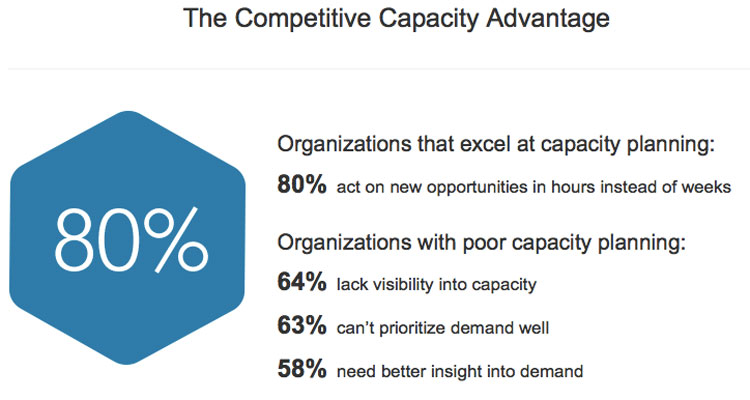
When it comes to planning projects, organizations often use spreadsheets and resource capacity planning templates to help them understand how demand compares with available resources. It can be a long, arduous set up. Eventually, you end up with the tabs of information and pivot tables to help you draw conclusions and make decisions.
Spreadsheets might be fine for organizations getting started with resource capacity planning. But, as the project portfolio advances, so does its complexity, resulting in a time consuming, error-prone resource capacity planning process that inhibits decision making and stifles innovation.
The Project Portfolio Management Landscape 2017 Report found that 86% of organizations leverage shared resources for both strategic and operational work. The 2016 State of Resource Management and Capacity Planning Benchmark Study found 80% of organizations that excel at capacity planning can act on new opportunities in hours, instead of weeks. By comparison, those with poor capacity planning lack visibility into capacity (64%), can’t prioritize demand well (63%), and need better insight into demand (58%).
Not only are you dealing with more projects, more money on the table, and higher risk and reward – you must also figure out how to make the most of shared resources. You need to understand where your valuable resources are spending their time while making sure the high-value projects are staffed; plus, your process must be flexible so you can take on new projects without it causing chaos, disruption, or financial loss.
The bottom line: Organizations need to learn how to manage resource capacity well or risk being left behind by competitors. You need visibility and information that will enable you to make the right business decisions. Is that error-prone spreadsheet going to get you there? Not likely.
So, how do you get there? Start by understanding the current state. It’s a simple, yet critical first step.
I recommend assessing your resource capacity planning practices by asking the following questions:
- Are we prioritizing demand effectively using spreadsheets?
- How long does it take us to adapt to incoming demand?
- How long does it take us to compare resource capacity and demand? Hours, days, or weeks?
- Is our data timely and accurate?
- Can we quickly understand resource capacity with the projects in-flight or planned?
- Can we conduct what-if scenarios?
- Are we delivering projects on time and on budget by using spreadsheets?
Depending on how you answer these questions will likely determine if you need to move from spreadsheets to a more purpose-built solution like portfolio and resource management. The right tool can help advance resource management and capacity planning to balance, prioritize, and schedule resource capacity with a real-time view into both future and in-flight work.
Want to see a purpose-built, resource capacity planning solution in action? I recommend watching Planview’s Portfolio and Resource Management demo. It features information on how you can align your project portfolios’ resources and spend, shows how to analyze capacity across portfolios and put the right people on the right work, provides comprehensive views into IT spend, resources, and demand across your entire enterprise, and much more.






